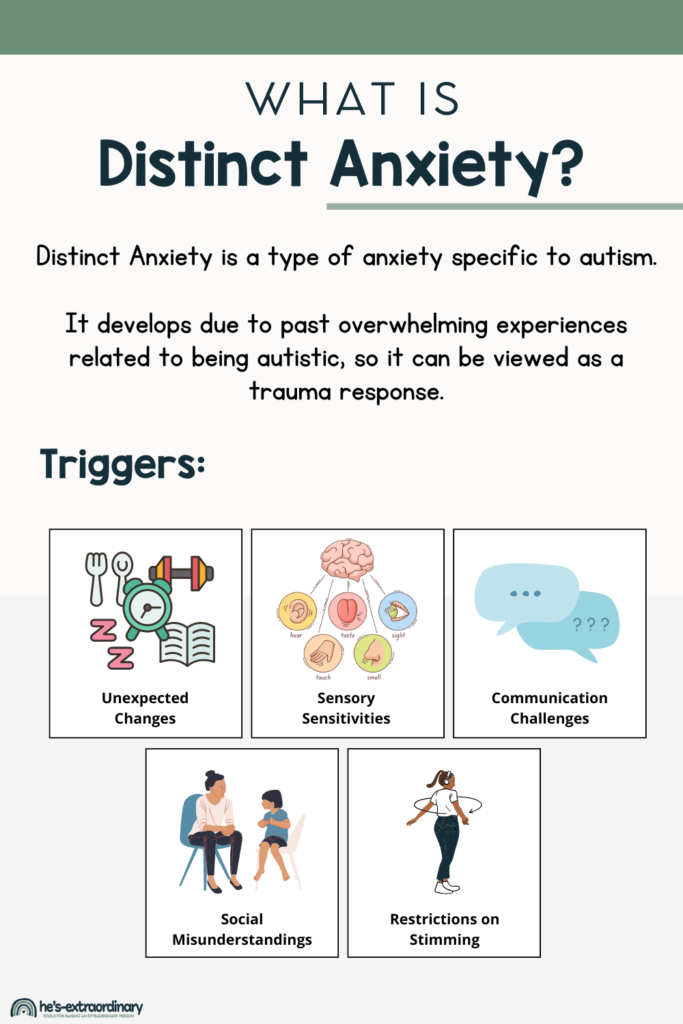What Is Distinct Anxiety in Autism? Supportive Strategies for Parents and Educators
What’s inside this article: A look at what distinct anxiety is, how it impacts autistic children, and what supportive strategies parents and educators can use to help kids feel safe, supported, and understood.
Did you know that there is a type of anxiety specific to autism that isn’t explained by any of the anxiety disorders currently included in the DSM V?
Researchers are calling this anxiety “distinct anxiety.”
This anxiety is deeply intertwined with the lived experiences of autistic individuals. It’s not just a set of symptoms; it’s a response to real challenges that autistic children (and adults) face daily.
As parents and educators, recognizing, validating, and empathetically responding to these experiences is a necessary component of supporting autistic children.
What is Distinct Anxiety?
Distinct anxiety in autism refers to anxiety that doesn’t align neatly with the categories typically described in clinical settings. This means it doesn’t fit the specific criteria used for other anxiety disorders like generalized anxiety or separation anxiety disorder.
It includes typical anxiety symptoms like excessive worry but also involves responses to stimuli unique to autistic individuals, such as changes in routine or sensory overload.
Anxiety is often viewed as worrying about something that likely won’t occur. But with distinct anxiety in autism, it’s a worry about a situation or event that does and has happened that’s distressing to someone with autism.
So, it’s complicated because it isn’t disproportionate or irrational; it’s a reasonable response to the individual’s experiences.
For example, they may have anxiety about having someone comment on their behavior or the way they dress because they’ve had people make these comments many times before. This can put them in an extremely uncomfortable social situation because they don’t know how to respond.
Distinct Anxiety is a Trauma Response
Since distinct anxiety develops due to past experiences, you can view it as a trauma response in autistic children (and adults).
Repeated stressful or overwhelming experiences—such as sensory overloads, social misunderstandings, and routine disruptions—can lead to chronic stress and even c-PTSD in people with autism.
Research shows that people with autism are more likely to develop c-PTSD from a single traumatic event or from recurring stressful situations like the ones associated with distinct anxiety than their neurotypical counterparts because of their brain differences.
So, you can expect to see behaviors like hypervigilance, avoidance, and meltdowns in response to distinct anxiety triggers.
Common Triggers of Distinct Anxiety:
The triggers can be specific to the individual depending on their unique strengths and challenges. But here are a few common triggers that seem to come up often:
- Unexpected Changes: Sudden changes in routines can be particularly stressful for autistic children, whose sense of security often relies on predictability. They can also have anxiety that their routine might change if there have been frequent disruptions.
- Sensory Sensitivities: Overwhelming sensory environments can provoke intense anxiety due to heightened sensory sensitivities. This can include classrooms, busy public spaces, etc.
- Communication Challenges: Difficulties interpreting social cues or expressing thoughts can lead to anxiety in social interactions as they try to anticipate what the people around them will say and do and how they should respond.
- Restrictions on Stimming: Criticism or restriction of self-stimulatory behaviors, which are coping mechanisms for stress and sensory regulation, can cause significant distress.
- Social Misunderstandings: Anxiety may also stem from past experiences of being misunderstood or not understanding others, which can lead to a fear of social interactions.

Supporting Autistic Children with Distinct Anxiety:
Distinct anxiety is a trauma response.
Understanding that to them, “distinct anxiety” is a logical response to life experiences rather than an unreasonable fear can help you provide more effective support and interventions.
Parents and educators should shift their perspective from trying to correct “disproportionate” reactions to addressing the environmental and social factors that contribute to these feelings of anxiety.
This approach leads to a more inclusive and supportive environment for autistic individuals.
Supportive Strategies for Distinct Anxiety:
- Validate Their Feelings: Recognize that the anxiety autistic children experience is a logical reaction to their experiences. Validation can alleviate feelings of isolation and build trust. Emotion coaching is a communication strategy that validates emotions and helps kids learn to communicate their feelings.
- Create Predictable Environments: Minimize changes to routines and schedules to prevent anxiety. When changes are necessary, prepare the child in advance to ease the transition. Find strategies for structuring your child’s environment here.
- Accommodate Sensory Needs: Be attentive to sensory sensitivities. Simple adjustments, like providing a quiet space, using softer lighting, or giving access to sensory equipment, can make a significant difference.
- Encourage and Respect Stimming: Understand that stimming is an essential self-regulation tool, not a behavior you should discourage. Allow children the space and freedom to engage in these activities. Teach neurotypical peers about stimming so they are less likely to judge or criticize their neurodiverse peers.
- Clear Communication: Reduce social misunderstands by using clear and straightforward language. You should also confirm understanding in both directions. If necessary, incorporate visuals. Encourage children to express their needs and feelings and respond to them with patience and clarity.
- Educate Peers and Community: Promote an inclusive community by educating peers about autism. Understanding and acceptance from classmates and community members can significantly reduce social anxiety because people are less likely to show criticism or judgment when they understand.
- The Step Ladder Approach: The step ladder approach is a cognitive-behavioral therapy (CBT) technique used to gradually expose individuals to situations that cause anxiety in a controlled way. This may help kids overcome specific triggers.
- Get Professional Support: When a child’s anxiety is negatively impacting their daily life, it’s important to discuss these challenges with their primary care provider. Professional support and intervention can drastically improve your child’s anxiety symptoms.
Remember
By understanding the roots of distinct anxiety in autistic children and adopting empathetic and supportive approaches, parents and educators can create environments where these children feel safe, supported, and understood.
These steps are not just about managing anxiety but also about affirming the child’s experiences and helping them navigate the world confidently.

